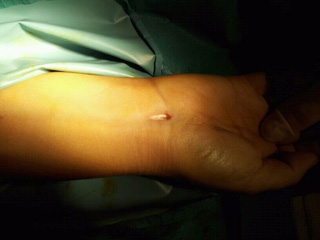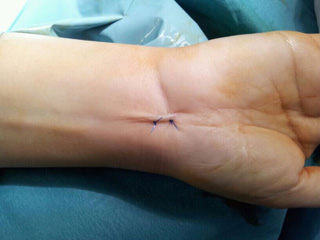Carpal tunnel syndrome is a median entrapment neuropathy produced at wrist level. It is located at the base of the palm. Flexor tendons and the median nerve pass through the carpal tunnel that is surrounded by the carpal bones that form an arch. The canal is narrow and rigid at distal forearm level. It is limited by pisiform, lunate, pyramidal, scaphoid bones in its proximal part; and by trapezium, trapezoid, large and hamate bones in its distal part. The ceiling side is delimited by a ligament called Flexor Retinaculum. Four tendons of the superficial common flexor muscle run through the tunnel; four tendons of the deep common flexor muscle of fingers run through it too along with the flexor pollicus longus of the thumb. The median nerve can be compressed by a decrease in the size of the canal, an increase in the size of the contents (swelling of tissues around tendons) or both. As a consequence it may alter the structure and function of the median nerve.
People with carpal tunnel syndrome experience numbness, tingling and pain in the wrists or hands with a burning or electric discharge sensation in the thumb, index and long and radial half of the ring finger. The patient feels pain running up its forearm till its shoulder. Firstly symptons are intermittent but long-standing carpal tunnel syndrome leads to permanent nerve damage. Patients may feel weakness of palmar abduction, loss of grip strength and trouble to do daily activities. What is more, it will probably move towards atrophy of some of the muscles of the thenar eminence which can be irreversible.
Clinical assessment is done by physical examination (tinel's sign, phalen's maneuver) and can be confirmed by an electromyography which objectively verify the median nerve dysfunction level. It is the most sensitive, specific and reliable diagnostic test and it ensures the presence of the compressed nerve. The test serves the purpose of knowing the median nerve conduction velocity, showing itself a slowed sensitive nerve conduction across the carpal tunnel.
The treatment depends on the kind of injury and its gravity. It can be started with mutivitamin treatment to help nourish the median nerve, postural measures, even local corticoid injections can relieve the medical clinic but it usually appears again.
Surgical treatment consists of cutting the transverse carpal ligament, what enlarges the tunnel and lessens pressure on the nerve. These methods have developed increasingly. At first, incisions about 5-6cm were done in the base of the palm, now we are releasing the transverse carpal ligament with an incision no bigger than 1cm by means of a specific tool that let visualise the nerve along its trajectory at tunnel level. This type of surgery means a quicker postoperative recovery of the sensitivity and early hand strength. It is an intervention that may be done under local anesthesia which allows the patient to use fingers and hand after leaving the operating room. If the patient suffers from a severe nerve injury, previous to the decompression, it may take time to recover hand strength and la sensitivity.











